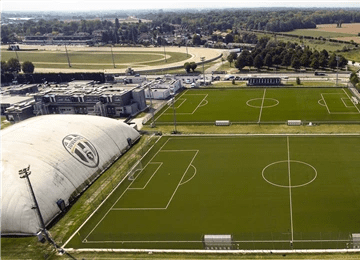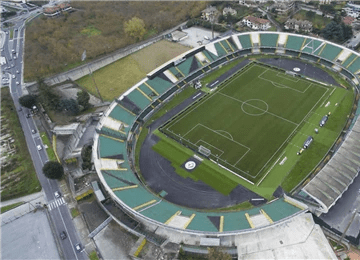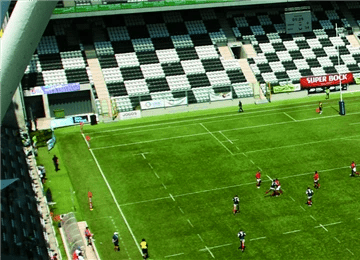Comprehensive guide to synthetic football turf: benefits, installation, and maintenance
Discover the advantages of synthetic football turf, how to choose the best type for your field, and essential maintenance tips.
The world of football is constantly evolving, and one of the most significant innovations is the use of synthetic turf for football fields. This technology has revolutionized how games are played and fields are maintained, offering numerous benefits over traditional grass. In this comprehensive guide, we will explore the advantages of synthetic football turf, how to select the best type for your field, and essential maintenance practices.
What you'll find on this page:
- What is a synthetic turf for football fields?
- Benefits of synthetic football turf
- How to choose the best synthetic turf for football
- Installation process
- Maintenance and care
- Synthetic turf, an essential component in football fields

What is a synthetic football turf?
Synthetic football turf, also known as artificial football turf, is a surface made of artificial fibers that mimic the appearance and functionality of natural grass. Initially developed for arenas and stadiums where maintaining natural grass was challenging due to weather conditions and heavy usage, synthetic turf is now widely used in professional and amateur football fields worldwide.
Benefits and advantages
Durability and resilience: One of the primary benefits of synthetic football turf is its durability. Unlike natural grass, which can become worn and patchy over time, synthetic turf is designed to withstand heavy use and harsh weather conditions. Products like Double X artificial football turf boast remarkable resilience and elastic memory, making them avant-garde playing surfaces. The unique double diamond shape and ultra-high double thickness enhance longevity, ensuring they can withstand UV rays, ice, and the rigors of regular play.
Consistent playing surface: Synthetic turf provides a consistent playing surface crucial for high-level football performance. This consistency helps reduce the risk of injuries caused by uneven ground or muddy patches, common issues with natural grass fields.
Low maintenance: Maintaining natural grass can be labor-intensive and costly, requiring regular watering, mowing, fertilizing, and pest control. In contrast, synthetic turf requires minimal maintenance, saving time and money. Products like Lesmo 3S, which combine the strengths of Double 4 and Lesmo HD, offer a tricolor design and tri-shape composition that not only enhances aesthetics but also minimizes maintenance requirements.
Weather resistance: Synthetic turf can be used in various weather conditions without becoming waterlogged or muddy. This allows for uninterrupted play and training sessions, regardless of the weather. For instance, the All Star synthetic turf, with its durable ESENE C6 polymers and HR anti-radiation products, remains cool in scorching climates and offers excellent reflectance and slip resistance, reducing abrasion and glare.
Environmental benefits: While there is some debate about the environmental impact of synthetic turf, it can reduce water usage and the need for chemical treatments such as fertilizers and pesticides, making it a more eco-friendly option in certain contexts.
How to choose the best synthetic turf for your football field
When selecting synthetic turf for a football field, several factors need to be considered to ensure it meets the specific needs of the players and the environment.
Fiber composition and structure
The quality and structure of the fibers are crucial for the performance and longevity of the turf. For example, Double X turf's double diamond shape and high thickness provide superior durability and performance. Similarly, All Star turf's unique fiber composition, with four distinct sections, offers a balance of resilience, comfort, coverage, and infill reinforcement.
Pile height and density
The pile height (the length of the turf fibers) and density (the number of fibers per square meter) affect the playing characteristics of the turf. Higher pile height and density generally provide a more natural feel and better shock absorption, which is essential for football.
Infill material
The infill material, which is placed between the turf fibers, plays a significant role in the performance of the synthetic turf. Common infill materials include sand, rubber, and organic options like cork. The right infill can enhance shock absorption, drainage, and the overall feel of the turf.
UV stability and weather resistance
Ensure that the synthetic turf is UV stabilized to prevent fading and degradation from sunlight exposure. Products like Double X and All Star are engineered to withstand UV rays and extreme weather conditions, ensuring long-term performance.
Maintenance requirements
While synthetic turf requires less maintenance than natural grass, some products are designed to be even more low-maintenance. Lesmo 3S, for example, is engineered to combine performance and aesthetics with minimal upkeep.

Installation process
The installation of synthetic football turf involves several critical steps to ensure a safe and high-performing playing surface.
- Site preparation: The first step is to prepare the site by removing existing grass and leveling the ground. Proper drainage systems should be installed to prevent waterlogging.
- Base layer installation: A base layer of crushed stone or gravel is laid down and compacted to create a stable foundation. This layer ensures proper drainage and supports the synthetic turf.
- Turf installation: The synthetic turf rolls are laid out and trimmed to fit the field dimensions. The edges are then secured, and seams are joined using adhesive or sewing techniques to create a seamless playing surface.
- Infill application: Infill material is spread evenly over the turf and brushed into the fibers. This step provides stability, shock absorption, and a natural feel to the turf.
- Final grooming: The final step involves grooming the turf to ensure the fibers are upright, and the infill is evenly distributed. This helps achieve the desired playing characteristics and aesthetics.
Maintenance and care
While synthetic turf requires less maintenance than natural grass, regular care is essential to ensure its longevity and performance.
Start by routinely cleaning the surface, removing debris such as leaves and trash, using a leaf blower or broom to keep it clean and free of contaminants. Periodically brushing the turf helps keep the fibers upright and maintains the infill distribution, preserving the playing characteristics and appearance of the turf.
Regularly check the infill levels and replenish them as needed to ensure proper shock absorption and stability. It's also important to inspect the turf regularly for any signs of wear, damage, or loose seams, and promptly address any issues to prevent further damage and ensure player safety.
Additionally, implement preventive measures, such as using turf covers during non-playing seasons or in extreme weather conditions, to protect the turf and extend its lifespan.

Synthetic turf, an essential component in football fields
Synthetic football turf has become an essential component in modern football fields, offering numerous benefits over natural grass, including durability, low maintenance, and consistent playing conditions.
By understanding the advantages and selecting the right type of synthetic turf, football enterprises can ensure optimal performance and longevity for their fields. Proper installation and regular maintenance are crucial to maximizing the benefits of synthetic turf and providing a safe, high-quality playing surface for players. With the right care, synthetic football turf can enhance the game experience.
- Via Crusnigo, 11
- 24030 Villa d'Adda (Bergamo)
- VAT number: IT01640880165
- Cod. Fiscale 07075130158
- Cod. Destinatario SUBM70N
- Shared capital: € 5,000,000
- REA BG 214799
- Phone number: +39 (035) 784-178
- Fax: +39 (035) 784-144
- Email: contact@italgreen.it
- PEC: italgreen@mailcertificata.org
- CLICK HERE to Whistleblowing

- Padel
- Artificial lawn
- Padel courts: benefits, construction and installation
- Build a tennis court: the complete guide by Italgreen
- Artificial grass manufacturers and suppliers
- Synthetic grass tennis court: benefits and supply
- Padel
- Artificial grass for sports
- Artificial grass manufacturers
- Sports artificial grass
- Synthetic grass manufacturer
- Italgreen: golf turf manufacturers and suppliers since 1983
- NEW LIMITED EDITION PADEL COURTS
- Padel court manufacturers: why choose Italgreen
- Sports turf manufacturers since 1983
- Indoor padel courts
- Italgreen’s synthetic soccer field
- The steps to replace the synthetic grass for padel
- Hybrid Turf
- High-quality artificial sports turf manufacturer
- Padel court supplier
- Artificial grass factory: Italgreen is at your disposal
- Soccer turf installation: a guide by Italgreen
- Padel court maintenance
- Synthetic Turf Suppliers
- Padel court builder: Italgreen is the solution
- Comprehensive guide to synthetic football turf: benefits, installation, and maintenance
- Field hockey turfs: a comprehensive guide